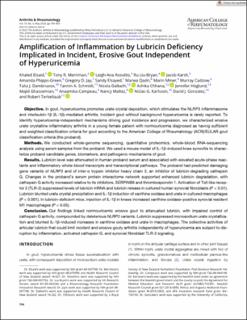| dc.description.abstract | Objective. In gout, hyperuricemia promotes urate crystal deposition, which stimulates the NLRP3 inflammasome and interleukin-1β (IL-1β)–mediated arthritis. Incident gout without background hyperuricemia is rarely reported. To identify hyperuricemia-independent mechanisms driving gout incidence and progression, we characterized erosive urate crystalline inflammatory arthritis in a young female patient with normouricemia diagnosed as having sufficient and weighted classification criteria for gout according to the American College of Rheumatology (ACR)/EULAR gout classification criteria (the proband).
Methods. We conducted whole-genome sequencing, quantitative proteomics, whole-blood RNA-sequencing analysis using serum samples from the proband. We used a mouse model of IL-1β–induced knee synovitis to charac- terize proband candidate genes, biomarkers, and pathogenic mechanisms of gout.
Results. Lubricin level was attenuated in human proband serum and associated with elevated acute-phase reac- tants and inflammatory whole-blood transcripts and transcriptional pathways. The proband had predicted damaging gene variants of NLRP3 and of inter-α trypsin inhibitor heavy chain 3, an inhibitor of lubricin-degrading cathepsin G. Changes in the proband’s serum protein interactome network supported enhanced lubricin degradation, with cathepsin G activity increased relative to its inhibitors, SERPINB6 and thrombospondin 1. Activation of Toll-like recep- tor 2 (TLR-2) suppressed levels of lubricin mRNA and lubricin release in cultured human synovial fibroblasts (P < 0.01). Lubricin blunted urate crystal precipitation and IL-1β induction of xanthine oxidase and urate in cultured macrophages (P < 0.001). In lubricin-deficient mice, injection of IL-1β in knees increased xanthine oxidase–positive synovial resident M1 macrophages (P < 0.05).
Conclusion. Our findings linked normouricemic erosive gout to attenuated lubricin, with impaired control of cathepsin G activity, compounded by deleterious NLRP3 variants. Lubricin suppressed monosodium urate crystalliza- tion and blunted IL-1β–induced increases in xanthine oxidase and urate in macrophages. The collective activities of articular lubricin that could limit incident and erosive gouty arthritis independently of hyperuricemia are subject to dis- ruption by inflammation, activated cathepsin G, and synovial fibroblast TLR-2 signaling. | en_US |

